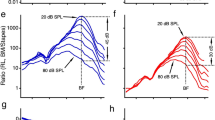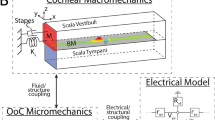Abstract
The spatial extent of the cochlear region that actually contributes to the DPOAE signal measured in the ear canal may be evaluated experimentally using interference tones or computed numerically using nonlinear cochlear models. A nonlinear transmission-line cochlear model is used in this study to evaluate whether the recently reported nonlinear behavior of the reticular lamina (RL) over a wide basal region may be associated with generation of a significant distortion product otoacoustic emission (DPOAE) component. A two-degrees-of-freedom 1-D nonlinear model was used as discussed by Sisto et al. (2019), in which each local element consists of two coupled oscillators, roughly representing the basilar membrane (BM) and the RL. In this model, the RL shows a strongly nonlinear response over a wide region basal to the characteristic place, whereas the BM response is linear outside the narrow peak region. Such a model may be considered as that using the minimal number of degrees of freedom necessary to separately predict the motion of the BM and RL, while preserving important cochlear symmetries, such as the zero-crossing invariance of the impulse response. In the numerical simulations, the RL nonlinearity generates indeed a large intracochlear distortion product source, extended down to very basal cochlear regions. Nevertheless, due to the weak and indirect coupling between the RL motion and the differential fluid pressure in the basal part of the traveling wave path, no significant contribution from this mechanism is predicted by the model to the generation of the DPOAE signal that is eventually measured in the ear canal.








Similar content being viewed by others
References
Abdala C, Sininger YS, Ekelid M, Zeng FG (1996) Distortion product otoacoustic emission suppression tuning curves in human adults and neonates. Hear Res 98:38–53
Botti T, Sisto R, Sanjust F, Moleti A, D'Amato L (2016) Distortion product otoacoustic emission generation mechanisms and their dependence on stimulus level and primary frequency ratio. J Acoust Soc Am 139:658–673
de Boer E (1990) Can shape deformations of the organ of Corti influence the travelling wave in the cochlea? Hear Res 44:83–92
Dewey JB, Applegate BE, Oghalai JS (2019) Amplification and suppression of traveling waves along the mouse organ of Corti: evidence for spatial variation in the longitudinal coupling of outer hair cell-generated forces. J Neurosci 39:1805–1816
Dong W, Olson ES (2008) Supporting evidence for reverse cochlear traveling waves. J Acoust Soc Am 123:222–240
Elliott SJ, Ku EM, Lineton B (2007) A state space model for cochlear mechanics. J Acoust Soc Am 122:2759–2771
Elliott JS, Ni G, Sun L (2017) Fitting pole-zero micromechanical models to cochlear response measurements. J Acoust Soc Am 142:666–679
Lee HY, Raphael PD, Park J, Ellerbee AK, Applegate BE, Oghalai JS (2015) Noninvasive in vivo imaging reveals differences between tectorial membrane and basilar membrane traveling waves in the mouse cochlea. Proc Natl Acad Sci U S A 112:3128–3133
Liu YW, Neely ST (2009) Outer hair cell electromechanical properties in a nonlinear piezoelectric model. J Acoust Soc Am 126:751–761
Lu TK, Zhak S, Dallos P, Sarpeshkar R (2006) Fast cochlear amplification with slow outer hair cells. Hear Res 214:45–67
Martin GK, Stagner BB, Lonsbury-Martin BL (2010) Evidence for basal distortion-product otoacoustic emission components. J Acoust Soc Am 127:2955–2972
Martin GK, Stagner BB, Dong W, Lonsbury-Martin BL (2016) Comparing distortion product otoacoustic emissions to Intracochlear distortion products inferred from a noninvasive assay. J Assoc Res Otolaryngol 17:271–287
Ren T, He W (2020) Two-tone distortion in reticular lamina vibration of the living cochlea. Commun Biol 3:35
Sasmal A, Grosh K (2019) Unified cochlear model for low- and high-frequency mammalian hearing. PNAS 116:13983–13988
Shera CA, Guinan JJ Jr (1999) Evoked otoacoustic emissions arise by two fundamentally different mechanisms: a taxonomy for mammalian OAEs. J Acoust Soc Am 105:782–798
Siegel JH (2018) Does reticular lamina active gain explain broad suppression tuning of SFOAEs? AIP Conf Proc 1965:140003. https://doi.org/10.1063/1.5038523Sisto
Sisto R, Wilson US, Dhar S, Moleti A (2018) Modeling the dependence of the distortion product otoacoustic emission response on primary frequency ratio. J Assoc Res Otolaryngol 19:511–522
Sisto R, Shera CA, Altoè A, Moleti A (2019) Constraints imposed by zero-crossing invariance on cochlear models with two mechanical degrees of freedom. J Acoust Soc Am 146:1685
Talmadge CL, Tubis A, Long GR, Piskorski P (1998) Modeling otoacoustic emission and hearing threshold fine structures. J Acoust Soc Am 104 1517–1543
Withnell RH, Lodde J (2006) In search of basal distortion product generators. J Acoust Soc Am 120:2116–2123
Author information
Authors and Affiliations
Corresponding author
Additional information
Publisher’s Note
Springer Nature remains neutral with regard to jurisdictional claims in published maps and institutional affiliations.
Rights and permissions
About this article
Cite this article
Moleti, A., Sisto, R. Does the “Reticular Lamina Nonlinearity” Contribute to the Basal DPOAE Source?. JARO 21, 463–473 (2020). https://doi.org/10.1007/s10162-020-00771-2
Received:
Accepted:
Published:
Issue Date:
DOI: https://doi.org/10.1007/s10162-020-00771-2




